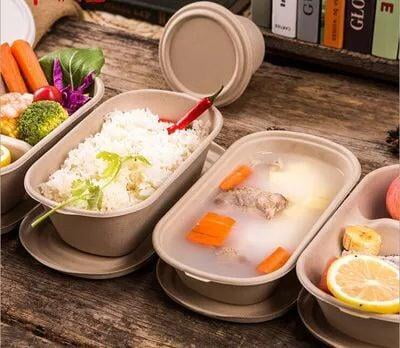In recent years, the frequency of ordering takeaway meals has increased significantly for reasons of time saving and food abundance. Is it possible to eat healthy when you entrust three meals a day to a catering takeaway? How can you tell the digital logo on a plastic box?
Most of the utensils used to serve takeaway meals in the market today are made of plastic. Those who are careful will notice that the plastic boxes you see in everyday life are marked with numbers, what do these numbers stand for? They represent the different materials of plastic and are generally indicated by the numbers 01 to 07.

No.1 Polyethylene terephthalate (PET)
Commonly used for mineral water bottles, carbonated beverage bottles, etc. This material is heat resistant to 70°C.
No.2 High Density Polyethylene (HDPE)
Commonly used to make plastic containers for cleaning products, bath products, etc. It can withstand temperatures up to 110 degrees Celsius, and plastic bags labelled for food can be used for food.
No.3 Polyvinyl chloride (PVC)
A toxic plastic product commonly used in the manufacture of building materials. The term "toxic" refers mainly to the single molecule of vinyl chloride that is not fully polymerised during the production process, and to the harmful substances in the plasticiser. These two substances precipitate easily when exposed to high temperatures.
No.4 Low Density Polyethylene (LDPE)
It is not very heat resistant and will melt when the temperature exceeds 110°C, leaving behind some plastic agents that cannot be decomposed by the human body. Therefore, when food is wrapped in this type of film and heated, the grease in the food will easily dissolve the harmful substances in the film.
No.5 Polypropylene (PP)
It is the only plastic box that can be put into the microwave oven and can be reused after cleaning. It is the only plastic box that can be put into the microwave oven.
No.6 Polystyrene (PS)
Commonly used to make noodle and fast food containers, it is heat and cold resistant. However, it should not be put into the microwave oven as it may release chemicals due to the high temperature and should not be used for strong acids and alkalis.
No.7 Other plastics (PC)
Contains Bisphenol A, which is harmful to health.
The above-mentioned plastics from 01 to 07 look somewhat specialised, but after understanding their respective uses you will understand that only 02, 05 and 06, i.e. high-density polyethylene (HDPE), polypropylene (PP) and polystyrene (PS) are relatively safe for making lunch boxes.
Are paper boxes safe?
Paperware for takeaway catering is currently available in two main categories.
One is the laminated paper lunch box, that is, the paper box has a thin layer of polyethylene plastic coating, equivalent to a layer of plastic film covering the paper surface. This paper lunch box can withstand a high temperature of about 90 ℃, suitable for hot and cold drinks, can play a good role in water insulation, the cost is higher than the plastic lunch box, the cost price is mostly not more than 1 yuan.
The other is the aluminium foil lunch box, which is of better quality than the laminated paper lunch box. Its raw material is non-toxic, easy to heat and does not produce harmful substances after heating; it is resistant to high temperatures, up to 660°C; it is easy to seal and has a strong barrier, which protects the original taste of food after sealing and extends the shelf life of food; it can be recycled efficiently. Aluminium foil lunch boxes are now promoted for use in airlines, high speed trains and primary and secondary schools. However, due to the high cost, they are less commonly used by takeaway caterers.
Given the variety of fast food boxes available on the market, it is important to pay attention to the digital markings on the plastic boxes when ordering takeaway food.

